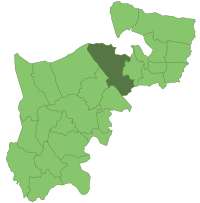Municipal Borough of Hendon
| Hendon | |
|---|---|
 Hendon Town Hall |
|
 Hendon within Middlesex in 1961 |
|
| Area | |
| • 1894 | 8,382 acres (34 km2) |
| • 1965 | 10,369 acres (42 km2) |
| Population | |
| • 1901 | 22,450 |
| • 1961 | 151,843 |
| History | |
| • Created | 1894 |
| • Abolished | 1965 |
| • Succeeded by | London Borough of Barnet |
| Status |
Urban district (1894-1932) Municipal borough (1932-1965) |
| • Motto | Endeavour |
Hendon was an ancient civil parish of around 8,250 acres (33 km2) which included Mill Hill, as well as Golders Green and Childs Hill. In 1894 it was created an urban district of Middlesex and in 1932 it became a municipal borough. The municipal borough was abolished in 1965 and the area became part of the London Borough of Barnet.
The name is Saxon and means the high down, and its earliest known use is in 1005 as Heandunigna. It was in the Hundred of Gore in the county of Middlesex. It had a vestry by the middle of the 17th century, becoming an urban district of Middlesex in 1894 and a municipal borough in 1932 (see the coat of arms and description. The municipal borough was abolished in 1965 and the area became part of the London Borough of Barnet. Between 1835 and 1930 Hendon Union was a poor Law Union, and census registrative District, which included a number of other parishes: Edgware, Great Stanmore, Little Stanmore, Kingsbury, Harrow on the Hill, Pinner, Willesden, as well as those areas in the ancient parish of Hendon. In 1932 the parish of Edgware (previously part of the Hendon Rural District) became a part of Hendon Urban District.
...
Wikipedia
